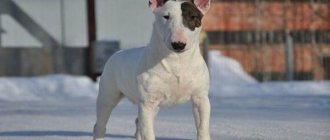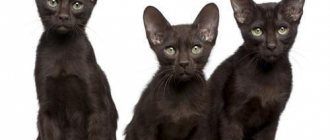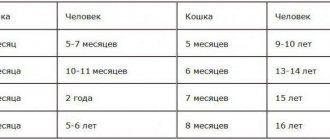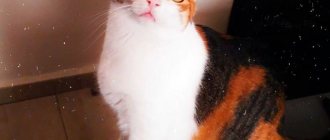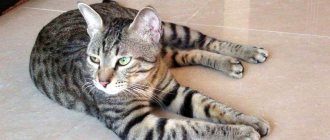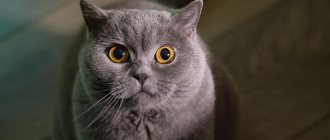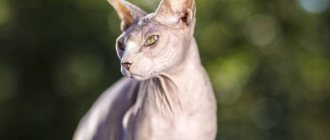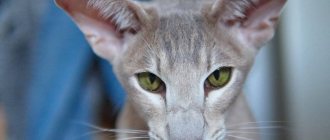Persian
Long silky hair (of any color), round green or yellow eyes, a flattened muzzle with an upturned nose - these are the characteristic features of a purebred Persian. His character can be either capricious or pliable, calm.
Thanks to the long, thick fur, the size of the Persian cat visually increases, but after a bath you can be very surprised by the size of the pet, because they will be much smaller than it seems.
Among the representatives of this cat breed there are also their own types:
- Classic (nose slightly below the eye line).
- European (the edge of the nose is at the same level as the lower eyelid).
- Extreme (nose in line with the inner corners of the eyes).
Exotic Shorthair
In shortened form, this breed of cat with a flattened muzzle and large eyes is called exotic. She owes her appearance to the crossing of Persians with an American shorthair cat. In appearance, exotics are very reminiscent of extreme Persians, but unlike the latter, they have short, soft hair, which saves owners from the need to spend a lot of time on regular grooming. Among the characteristic features: strong short legs, an expanded chest and large size (the weight of some animals exceeds 8 kg). The color of representatives can be very diverse, from white and black to noble blue.
The cute plush appearance of the exotic cat fully matches its character. These pets differ from their Persian ancestors in a more affectionate, playful disposition, without unnecessary aggression, and therefore are considered an ideal option for families with children. They rarely speak, love their owner very much and get along without problems in the same territory with other animals.
Cat breeds with big eyes
Big-eyed cats are different. The gaze of some can be called purposeful and cunning, while others can only express adoration for a person or a plea for a tidbit with their eyes.
Dilated pupils, like saucer eyes, add special significance to a cat’s gaze. Peering into their depths, people rarely realize what kind of eyes their pet has: round, almond-shaped or slanted. The first two types can confidently be called large.
The owners of large eyes can be different cats: long-haired or short-haired, small or medium-sized, with or without a tail. The most popular breeds of big-eyed cats:
- Persian;
- British;
- Scottish lop-eared;
- Abyssinian;
- Japanese Bobtail;
- Singapore;
- Ukrainian Levkoy;
- ragdoll
Persian cat
This is the name of the breed with long fluffy hair and a flattened muzzle with a snub nose. Persian cats are incredibly popular. Breeders love the gentle, calm nature and cozy appearance of animals. Persian cat eyes:
- Perfect round shape;
- Clearly stand out against the background of the muzzle;
- They have different shades, depending on the color of the coat.
Persian cats require daily care. The coat should be combed and washed with a special shampoo. The animal needs regular intake of vitamins to maintain the condition of its hair.
The cost of a big-eyed Persian cat varies from 2 to 16 thousand rubles, depending on the pedigree.
This is interesting! Cats' true eye color may not appear until they are one year old. Up to six months, cats have a dull blue tint to their eyes.
British
It seems that the large, wide-set eyes of these cats are wide open to the whole world. And at the same time they look quite intently, which makes their gaze even more open. Often, British eyes have an intense copper tint, less often blue or green.
As for character, these cats are mostly calm and balanced. In addition, they are smart, strong and kind. And for their independence and purely English manners, these animals received the nickname - cats for businessmen. The British undoubtedly love their breadwinners, but at the same time they tolerate their long absence quite calmly and, being alone, always find something to do.
Scottish lop-eared
The Scottish Fold (Scottish Fold) is an animal with a stocky build and floppy ears that completely cover the pinna. Folds seem heavy due to their round head and short legs, and their tail is of medium size. However, the Scots cannot be called heavyweights. A cat can only grow up to 6–7 kg, and a cat can only grow up to 4–4.5 kg. With their large eyes, small nose and wide-set floppy ears, these cats look naive (like toys), but that's what people like about them. The fold can be any color (there are more than 60 types).
The Scots are calmness itself. Such a cat can be confidently called the most balanced. He is not lazy, but extremely peaceful, so he gets along well with all family members. The big-eyed, fold-eared cat will make friends with any other pets, because he is smart and understands that they are also part of the family. But this cat does not really like strangers. He, of course, will not rush at the guests, but he will not caress them either.
Himalayan
Another breed of cat with a short nose is the Himalayan, obtained from crossing Persians with Siamese. It is recognized only by the TICA and CFF associations. Others consider it a subspecies of the Persian and register it that way.
In addition to the snub nose, the distinctive features of the Himalayan's appearance include bright blue eyes, a large body with short legs and increased fluffiness. The coat color is color point with transitions from beige on the body to dark brown on the nose, ears, tail and limbs.
Pets of the Himalayan breed are distinguished by a calm, even lazy character: they rarely play, and like to sleep more than others. Due to this lethargy, they can be called ideal pets for cuddling.
With some stretch, British Shorthair and Scottish Fold cats can also be considered breeds with a flat nose. The brachycephalic type of skull is not as pronounced in them as in the Persians, Exotics and Himalayans presented above.
How they appeared and what they are
Some scientists argue that Persian cats have existed since the founding of Persia. Although references to charming cats with luxurious fur date back to the 17th century.
They first spread to the court of the French king thanks to Cardinal de Richelieu. It was he who introduced the fashion for such exotic animals at that time.
The emergence of the Persian Longhair dates back to 1887. Then they were divided into several subspecies, which served as an incentive for the creation of clubs for cat lovers. And at the beginning of the 20th century they became the first breed officially recognized by the English Felinological Association.
In the 20s, a subtype of the Persian appeared - extreme, and in the 50s, by crossing it with a Siamese, the Himalayan cat was created. In the 60s, a Persian cat gave birth to kittens from an American Shorthair, which were later called Exotic Shorthairs. In the Soviet Union, they first learned about such pets in 1980, and their breeding began in 1991.
Among the distinctive features of snub-nosed cats are the following characteristics:
- brachycephalic muzzle with a depressed nose;
- cheeky head, the width of which is more than 80% of the height;
- stocky build with a small body and short powerful legs;
- small ears widely spaced on the head;
- thick plush fur of medium or long length.
Such pets are very affectionate and pliable, friendly with others, and especially with children. They become very attached to their owner, with whom they like to spend as much time as possible.
Manul
Despite the fact that breeds with a flattened face are bred artificially, there are also cats in nature with this feature. This is a Pallas's cat that lives in the countries of Central Asia. It is approximately the same size as its domestic relatives, but has a more “predatory” appearance: a squat, massive body with short legs, a flat skull with a powerful jaw, and very thick long hair. The image is complemented by a small head with small rounded ears and yellow eyes.
Thanks to its brachycephalic skull, the Pallas cat has two advantages. Firstly, a strong jaw, which allows you to firmly hold your prey. Secondly, the ability to breathe through your mouth, so as not to loosen your iron grip even for a minute. The color with a combination of light gray and yellow-brown shades provides reliable camouflage in the wild, which is especially important during hunting. Pallas's cat is a rare species of animal and is listed in the Red Book. Despite this, there are those who want to domesticate it, which is almost impossible to do in reality.
Brachycephalic cat breeds
- British Shorthair;
- Scottish lop-eared;
- Himalayan;
- exotic;
- Persian
CFA (Cat Fanciers Association) annually publishes a ranking of the most popular breeds. For many years, kittens with flattened faces have been at the top of the rankings, which indicates their popularity.
British Shorthairs with a slightly flat nose
The British cat is characterized by a round, plump muzzle, slightly sagging cheeks, and small, neat ears. The animals have a squat, dense body and strong limbs.
In British cats, brachycephalic syndrome manifests itself to the least extent. They are distinguished by a short, wide and straight nose, which forms a vertical line with the chin.
British Shorthair cats are self-sufficient, they tolerate loneliness calmly and do not like noisy companies and active games. They are great for singles who spend a lot of time at work. These animals have a sense of self-esteem, so they expect respect from others.
Features of care
Many people like flat-faced cats for their innocent expression and unusual appearance. But if you want to become the owner of such a pet, you should take into account the possible difficulties of keeping them:
- Breathing problems. Due to their narrow, shortened airways, flat-faced cats often wheeze and snore while sleeping and even while feeding. They have a particularly difficult time with nasal congestion due to colds, so when choosing a Persian or exotic as a pet, it is especially important to regularly monitor the air temperature in the house and prevent hypothermia.
- Increased tear production. Due to shortened tear ducts, the risk of developing infection and suppuration under the eyelids increases. To prevent complications and for preventive purposes, watery eyes should be wiped with a cloth or paper napkin moistened with a special solution.
- Features of feeding. First, the food bowl must be wide enough. Secondly, not all pets can eat carefully. Despite the natural cleanliness of cats and regular licking, periodically the hair in the neck and mouth area needs to be wiped with a damp sponge. Some animals cannot eat food on their own at all, so owners have to spoon feed them.
Health of brachycephalic cats
Sometimes brachycephaly causes serious health problems and requires mandatory veterinary care:
- Stenosis (narrowing) of the nostrils. Narrow nostrils impede normal breathing. The animal makes great efforts to inhale.
- Long soft palate. The elongated palate blocks most of the epiglottis, preventing normal air passage and promoting tissue inflammation. Narrow nostrils and a long palate cause constant wheezing, wheezing or snoring.
- Tracheal stenosis. Exacerbates problems with the respiratory system. There is an increased retraction of the walls of the trachea inward, which gradually destroys the organ.
The problems described above provoke a decrease in intrathoracic pressure and even pulmonary edema. The body tries to compensate for the lack of oxygen by narrowing the arteries in the lungs. As a result, the load on the heart increases several times, which leads to right-sided cardiovascular failure. At the first suspicious symptoms, you should immediately contact a veterinarian.
